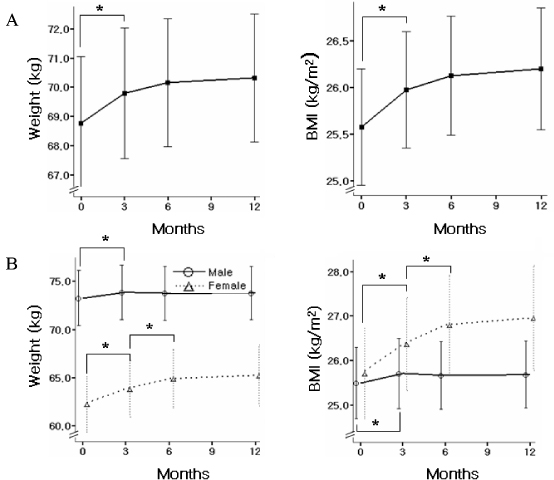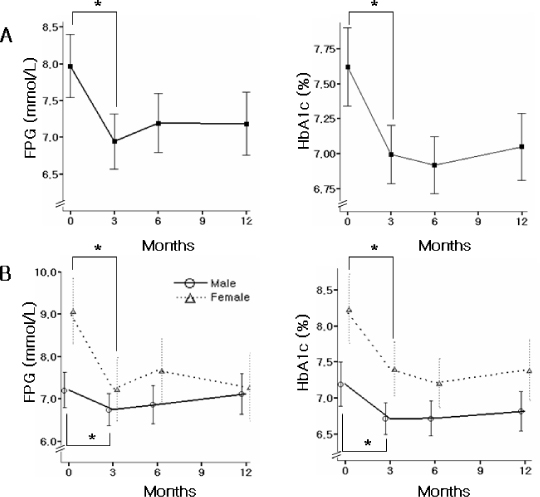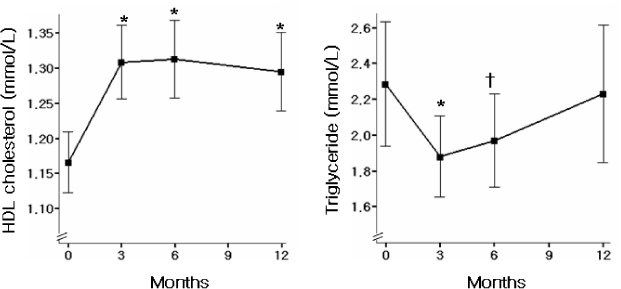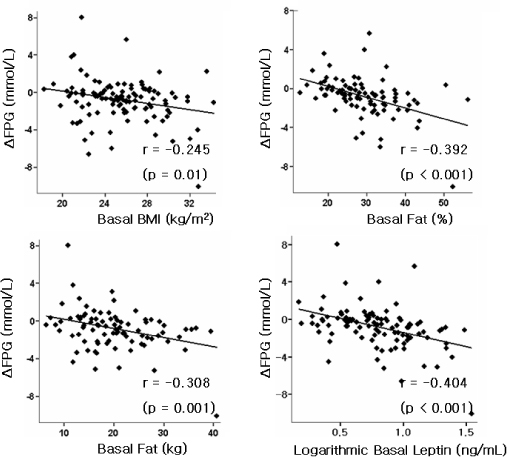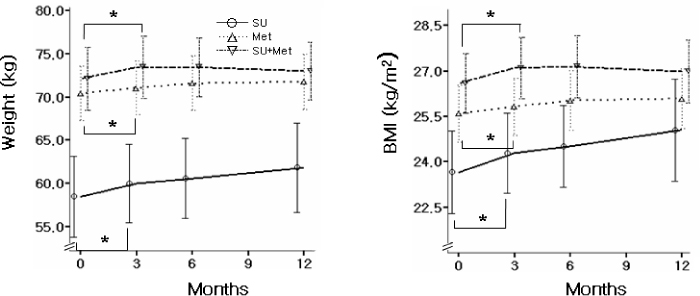J Korean Diabetes Assoc.
2006 Jul;30(4):264-276. 10.4093/jkda.2006.30.4.264.
Long-term Effect of Pioglitazone Treatment in Patients with Type 2 Diabetes
- Affiliations
-
- 1Department of Internal Medicine, Yonsei University College of Medicine, Korea.
- 2Department of Internal Medicine, Pochon CHA Univercity College of Medicine, Korea.
- KMID: 2177598
- DOI: http://doi.org/10.4093/jkda.2006.30.4.264
Abstract
-
BACKGROUND: Type 2 diabetes is characterized by impaired insulin secretion and/or insulin resistance. Thiazolidinediones have been shown to ameliorate insulin resistance. The purpose of the present study was to evaluate the long term serial effect of pioglitazone on anthropometrics and metabolic parameters in Korean type 2 diabetes patients.
METHODS
One hundred thirteen type 2 diabetes patients (male, 67; female, 46; mean age, 49.1+/-10.8 years) were evaluated before and after 3 months, 6 months and 12 months of treatment with pioglitazone (Actos(TM), 15 mg/day). Anthropometric parameters and metabolic variables were measured.
RESULTS
Body weight and body mass index (BMI) were increased in 3 months after pioglitazone treatment (body weight, 68.8+/-12.2 vs 69.8+/-11.9 kg, P < 0.01) without further increase. In women, body weight and BMI tended to increase more (body weight change after 3 months, 0.6+/-1.7 kg vs 1.6+/-1.7 kg, P < 0.01) and longer (3 months vs 6 months) than in men. Fasting plasma glucose (FPG) and HbA1c were decreased in 3 months after pioglitazone treatment (FPG, 7.97+/-2.29 vs 6.94+/-2.01 mmol/L, P < 0.01; HbA1c, 7.7+/-1.5 vs 7.0+/-1.1%, P < 0.01). Hypoglycemic effect of pioglitazone was prominent in women than in men (FPG change after 12 months, -1.80+/-2.54 vs -0.09+/-1.72 mmol/L, P < 0.001; HbA1c change after 12 months, -0.9+/-1.3 vs -0.4+/-1.1%, P < 0.05). Serum high-density lipoprotein cholesterol was increased after 3 months of pioglitazone treatment (1.16+/-0.24 vs 1.31+/-0.28 mmol/L, P < 0.01) without return until the end of this study. Serum triglycerides level decreased at 3 months (basal vs 3 months, 2.29+/-1.86 vs 1.88+/-1.21 mmol/L, P < 0.01) and 6 months (basal vs 6 months, 2.29+/-1.86 vs 1.97+/-1.40 mmol/L, P < 0.05) of pioglitazone treatment, but returned to basal level at 12 months. Liver enzyme, especially serum alanine transferase level decreased after 3 months of pioglitazone treatment (30.8+/-23.7 vs 24.5+/-18.5 IU/L, P < 0.01) without return until the end of this study. Hypoglycemic effect of pioglitazone was associated with basal BMI, fat contents and serum leptin level.
CONCLUSION
Korean type 2 diabetes patients with pioglitazone use showed favorable metabolic effect for glycemic control, lipid metabolism and liverfunction, but pioglitazone induced body weight increase may be limited.
Keyword
MeSH Terms
-
Alanine
Blood Glucose
Body Mass Index
Body Weight
Cholesterol
Fasting
Female
Humans
Hypoglycemic Agents
Insulin
Insulin Resistance
Leptin
Lipid Metabolism
Lipoproteins
Liver
Male
Thiazolidinediones
Transferases
Triglycerides
Alanine
Cholesterol
Hypoglycemic Agents
Insulin
Leptin
Lipoproteins
Thiazolidinediones
Transferases
Triglycerides
Figure
Cited by 1 articles
-
Therapeutic Effect of Quadruple Oral Hypoglycemic Agents in Patients with Type 2 Diabetes Mellitus Who Have Insulin Limitations
Won Sang Yoo, Do Hee Kim, Hee Jin Kim, Hyun Kyung Chung
J Korean Diabetes. 2019;20(2):117-126. doi: 10.4093/jkd.2019.20.2.117.
Reference
-
1. Saltiel AR, Olefsky JM. Thiazolidinediones in the treatment of insulin resistance and type 2 diabetes. Diabetes. 1996. 45:1661–1669.2. Iwamoto Y, Akanuma Y, Kosaka K, Shigeta Y, Kuzuya T, Kaneko T. Effects of troglitazone: a new hypoglycemic agent in patients with NIDDM poorly controlled by diet therapy. Diabetes Care. 1996. 19:151–156.3. Suter SL, Nolan JJ, Wallace P, Gumbiner B, Olefsky JM. Metabolic effects of neworal hypoglycemic agent CS-045 in NIDDM subjects. Diabetes Care. 1992. 15:193–203.4. Lehmann JM, Moore LB, Smith-Oliver TA. An antidiabetic thiazolidinedione is a high affinity ligand for peroxisome proliferator-activated receptor gamma. J Biol Chem. 1995. 270:12953–12956.5. Nolan JJ, Ludvik B, Beerdsen P, Joyce M, Olefsky J. Improvement in glucose tolerance and insulin resistance in obese subjects treated with troglitazone. N Engl J Med. 1994. 331:1188–1193.6. Stumvoll M. Thiazolidinediones-some recent developments. Expert Opin Investig Drugs. 2003. 12:1179–1187.7. Camp HS. Thiazolidinediones in diabetes: Current status and future outlook. Curr Opin Investig Drugs. 2003. 4:406–411.8. Neuschwander-Tetri BA, Brunt EM, Wehmeier KR, Oliver D, Bacon BR. Improved nonalcoholic steatohepatitis after 48 weeks of treatment with thePPAR-gamma ligand rosiglitazone. Hepatology. 2003. 38:1008–1017.9. Bajaj M, Suraamornkul S, Pratipanawatr T, Hardies LJ, Pratipanawatr W, Glass L, Cersosimo E, Miyazaki Y, DeFronzo RA. Pioglitazone reduces hepatic fat content andaugments splanchnic glucose uptake in patients with type 2 diabetes. Diabetes. 2003. 52:1364–1370.10. Adams M, Montague CT, Prins JB, Holder JC, Smith SA, Sanders L, Digby JE, Sewter CP, Lazar MA, Chatterjee VK, O'Rahilly S. Activators of peroxisome proliferator activated receptor have depot-specific effects on human preadipocyte differentiation. J Clin Invest. 1997. 100:3149–3153.11. Zimmet P. Addressing the insulin resistance syndrome: A role for the thiazolidinediones. Trends Cardiovasc Med. 2002. 12:354–362.12. Hirose H, Kawai T, Yamamoto Y, Taniyama M, Tomita M, Matsubara K, Okazaki Y, Ishii T, Oguma Y, Takei I, Saruta T. Effects of pioglitazone on metabolic parameters, body fat distribution, and serum adiponectin levels in Japanese male patients with type 2 diabetes. Metabolism. 2002. 51:314–317.13. Derosa G, Cicero AF, Gaddi A, Ragonesi PD, Fogari E, Bertone G, Ciccarelli L, Piccinni MN. Metabolic effects of pioglitazone and rosiglitazone in patients with diabetes and metabolic syndrome treated with glimepiride: a twelve-month, multicenter, double-blind, randomized, controlled, parallel-group trial. Clin Ther. 2004. 26:744–754.14. Shadid S, Jensen MD. Effects of pioglitazone versus diet and exercise on metabolic health and fat distribution in upper body obesity. Diabetes Care. 2003. 26:3148–3152.15. Smith SR, De Jonge L, Volaufova J, Li Y, Xie H, Bray GA. Effect of pioglitazone on body composition and energyexpenditure: a randomized controlled trial. Metabolism. 2005. 54:24–32.16. Kelly IE, Han TS, Walsh K, Lean MEJ. Effects of a thiazolidinedione compound on body fat and fat distribution of patients with type 2 diabetes. Diabetes Care. 1999. 22:288–293.17. Kawai T, Takei I, Oguma Y, Ohashi N, Tokui M, Oguchi S, Katsukawa F, Hirose H, Shimada A, Watanabe K, Saruta T. Effects of troglitazone on fat distribution in the treatment of male type 2 diabetes. Metabolism. 1999. 48:1102–1107.18. Akazawa S, Sun F, Ito M, Kawasaki E, Eguchi K. Efficacy of troglitazone on body fat distribution in type 2 diabetes. Diabetes Care. 2000. 23:1067–1071.19. King AB, Armstrong DU, Chinnapongse S. Clinical observations of weight gain associated with pioglitazone: 3 years. 2003. In : American Diabetes Association 63rd Scientific Sessions; New Orleans, LA.20. Suzuki R, Watanabe S, Hirai Y, Akiyama K, Nishide T, Matsushima Y, Murayama H, Ohshima H, Shinomiya M, Shirai K. Abdominal wall fat index, estimated by ultrasonography, for assessment of the ratio of visceral fat to subcutaneous fat in the abdomen. Am J Med. 1993. 95:309–314.21. Armellini F, Zamboni M, Rigo L, Bergamo-Andreis IA, Robbi R, De Marchi M, Bosello O. Sonography detection of small intra-abdominal fat variations. Int J Obes Relat Metab Disord. 1991. 15:847–852.22. Kim SK, Kim HJ, Hur KY, Choi SH, Ahn CW, Lim SK, Kim KR, Lee HC, Huh KB, Cha BS. Visceral fat thickness measured by ultrasonography can estimate not only visceral obesity but also risks of cardiovascular and metabolic diseases. Am J Clin Nutr. 2004. 79:593–599.23. Lowell BB. PPARgamma: an essential regulator of adipogenesis and modulator of fat cell function. Cell. 1999. 99:239–242.24. Spiegelman BM, Flier JS. Adipogenesis and obesity: rounding out the big picture. Cell. 1996. 87:377–389.25. Okuno A, Tamemoto H, Tobe K, Ueki K, Mori Y, Iwamoto K, Umesono K, Akanuma Y, Fujiwara T, Horikoshi H, Yazaki Y, Kadowaki T. Troglitazone increases the numberof small adipocytes without the change of white adipose tissuemass in obese Zucker rats. J Clin Invest. 1998. 101:1354–1361.26. Yamauchi T, Kamon J, Waki H, Murakami K, Motojima K, Komeda K, Ide T, Kubota N, Terauchi Y, Tobe K, Miki H, Tsuchida A, Akanuma Y, Nagai R, Kimura S, Kadowaki T. The mechanisms by which both heterozygous peroxisome proliferator-activated receptor gamma (PPARgamma) deficiency and PPARgamma agonist improve insulin resistance. J Biol Chem. 2001. 276:41245–41244.27. Mori Y, Murakawa Y, Okada K, Horikoshi H, Yokoyama J, Tajima N, Ikeda Y. Effect of troglitazone on body fat distribution in type 2 diabetic patients. Diabetes Care. 1999. 22:908–912.28. Anderson LA. The effects of androgens and estrogens on preadipocyte proliferation in human adipose tissue: influence of gender and site. J Clin Endocrinol Metab. 2001. 86:5045–5051.29. Dieudonne MN, Pecquery R, Boumediene A, Leneveu MC, Giudicelli Y. Androgen receptors in human preadipocytes and adipocytes: regional specificities and regulation by sex steroids. Am J Physiol. 1998. 274:1645–1652.30. Dieudonne MN, Pecquery R, Leneveu MC, Giudicelli Y. Opposite effects of androgens and estrogens on adipogenesis in rat preadipocytes: evidence for sex and siterelated specificities and possible involvement of insulin-like growth factor1 receptor and peroxisome proliferator-activated receptor gamma2. Endocrinology. 2000. 141:649–656.31. Fujita Y, Yamada Y, Kusama M, Yamauchi T, Kamon J, Kadowaki T, Iga T. Sex differences in the pharmacokinetics of pioglitazone in rats. Comp Biochem Physiol C Toxicol Pharmacol. 2003. 136:85–94.32. Hanefeld M, Brunetti P, Schernthaner G, Mattews D, Charbonnel B. One-year glycemic control with a sulfonylurea plus pioglitazone versusa sulfonylurea plus metformin in patients with type 2 Diabetes. Diabetes Care. 2004. 27:141–147.33. Lawrence J, Reid J, Taylor G, stirling C, Reckless J. Favorable effect of pioglitazone and metformin compared with gliclazide on lipoprotein subfractions in overweight patients with early type 2 diabetes. Diabetes Care. 2004. 27:41–46.34. Winkler K, Konrad T, Fullert S, Friedrich I, Destani R, Baumstark MW, Krebs K, Wieland H, Marz W. Pioglitazone reduces atherogenic dense LDL particles in nondiabetic patients with arterial hypertension: a double-blind, placebo-controlled study. Diabetes Care. 2003. 26:2588–2594.35. Parhofer KG, Otto C, Geiss HC, Laubach E, Goke B. Effect of pioglitazone on lipid in well controlled patients with diabetes mellitus type2-result of pilot study. Exp Clin Endocrinol Diabetes. 2005. 113:49–52.36. Camp HS. Thiazolidinediones in diabetes: current status and futureoutlook. Curr Opin Investig Drugs. 2003. 4:406–411.37. Shelness GS, Sellers JA. Very-low-density lipoprotein assembly and secretion. Curr Opin Lipidol. 2001. 2:151–157.38. Keating GM, Ormond D. Micronised fenofibrate: an updated review of its clinical efficacy in the management of dyslipidemia. Drugs. 2002. 62:1909–1944.39. Goto T, Omura T, Takebe K, Kral JG. The influence of fatty liver on insulin clearance and insulin resistance in non-diabetic Japanese subjects. Int J Obes. 1995. 19:841–845.40. Banerji MA, Buckley MC, Chaiken RL, Gordon D, Lebowitz HE, Kral JG. Liver fat, serum triglycerides and visceral adipose tissuein insulin-sensitive and insulin-resistant black men with NIDDM. Int J Obes. 1995. 19:846–850.41. Marchesini G, Brizi M, Morselli-Labate AM, Bianchi G, Bugianesi E, McCullough AJ, Forlani G, Melchionda N. Association of nonalcoholic fatty liver disease to insulin resistance. Am J Med. 1999. 107:450–455.42. Marchesini G, Brizi M, Bianchi G, Tomassetti S, Bugianesi E, Lenzi M, McCullough AJ, Natale S, Forlani G, Melchionda N. Non-alcoholic fatty liver disease: a feature of the metabolic syndrome. Diabetes. 2001. 50:1844–1850.43. Katoh S, Hata S, Matsushima M, Ikemoto S, Inoue Y, Yokoyama J, Tajima N. Troglitazone prevents the rise in visceral adiposity and improves fatty liver associated with sulfonylurea therapy-a randomized controlled trial. Metabolis. 2001. 50:414–417.44. Bajaj M, Suraamornkul S, Pratipanawatr T, Hardies LJ, Pratipanawatr W, Glass L, Cersosimo E, Miyazaki Y, DeFronzo RA. Pioglitazone reduces hepatic fat content and augments splanchnic glucose uptake in patients with type 2 diabetes. Diabetes. 2003. 52:1364–1370.45. Fulgencio JP, Kohl C, Girard J, Pegorier JP. Troglitazone inhibits fatty acid oxidation and esterification, and gluconeogenesis in isolated hepatocytes from starved rats. Diabetes. 1996. 45:1556–1562.46. Kelly IE, Han TS, Walsh K, Lean MEJ. Effects of a thiazolidinedione compound on body fat and fat distribution of patients with type 2 diabetes. Diabetes Care. 1999. 22:288–293.47. Ono M, Ikegami H, Fujisawa T, Nojima K, Kawabata Y, Nishino M, Taniguchi H, Itoi-Babaya M, Babaya N, Inoue K, Ogihara T. Improvement of liver function parameters in patients with type 2 diabetes treated with thiazolidinediones. Metabolism. 2005. 54:529–532.

